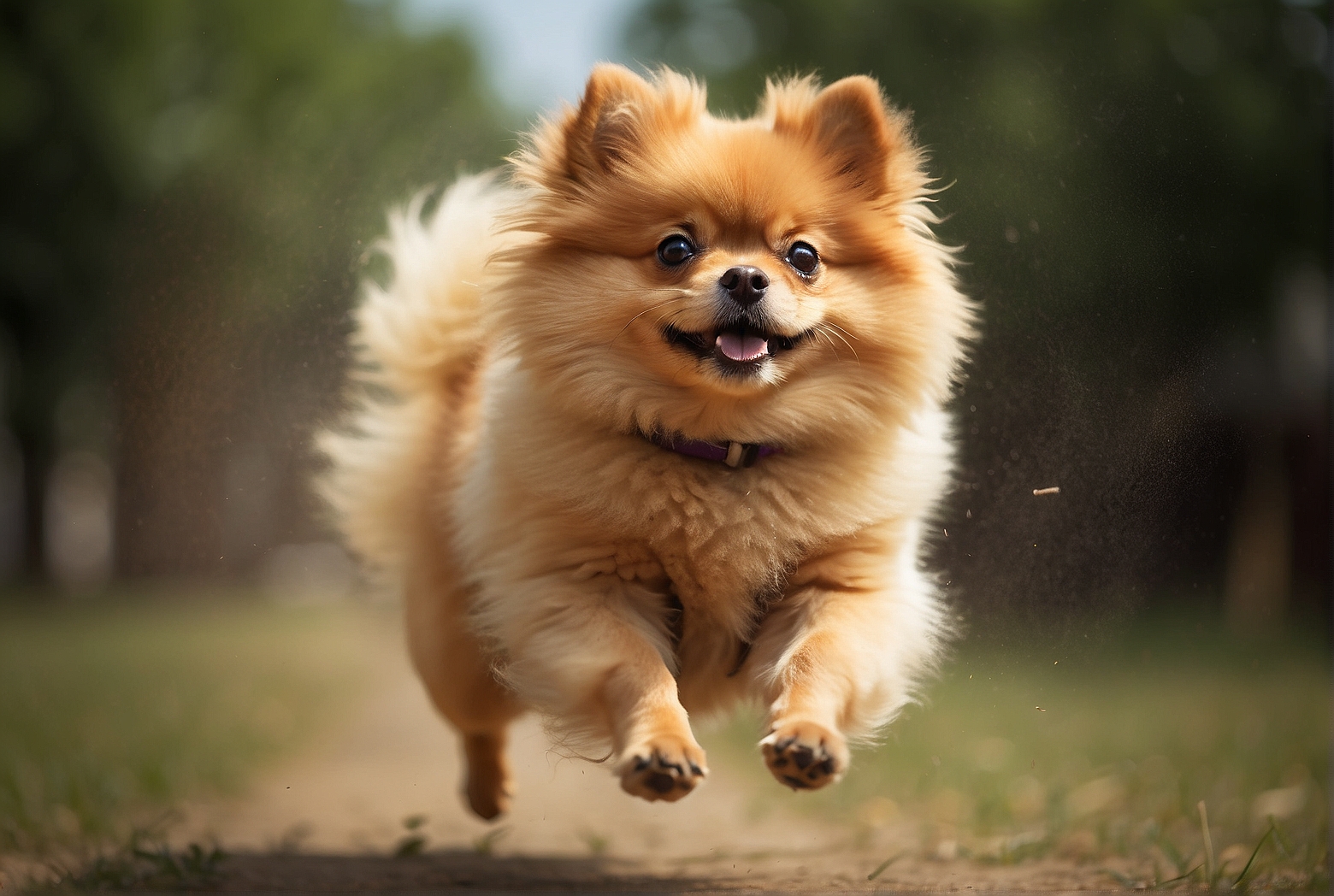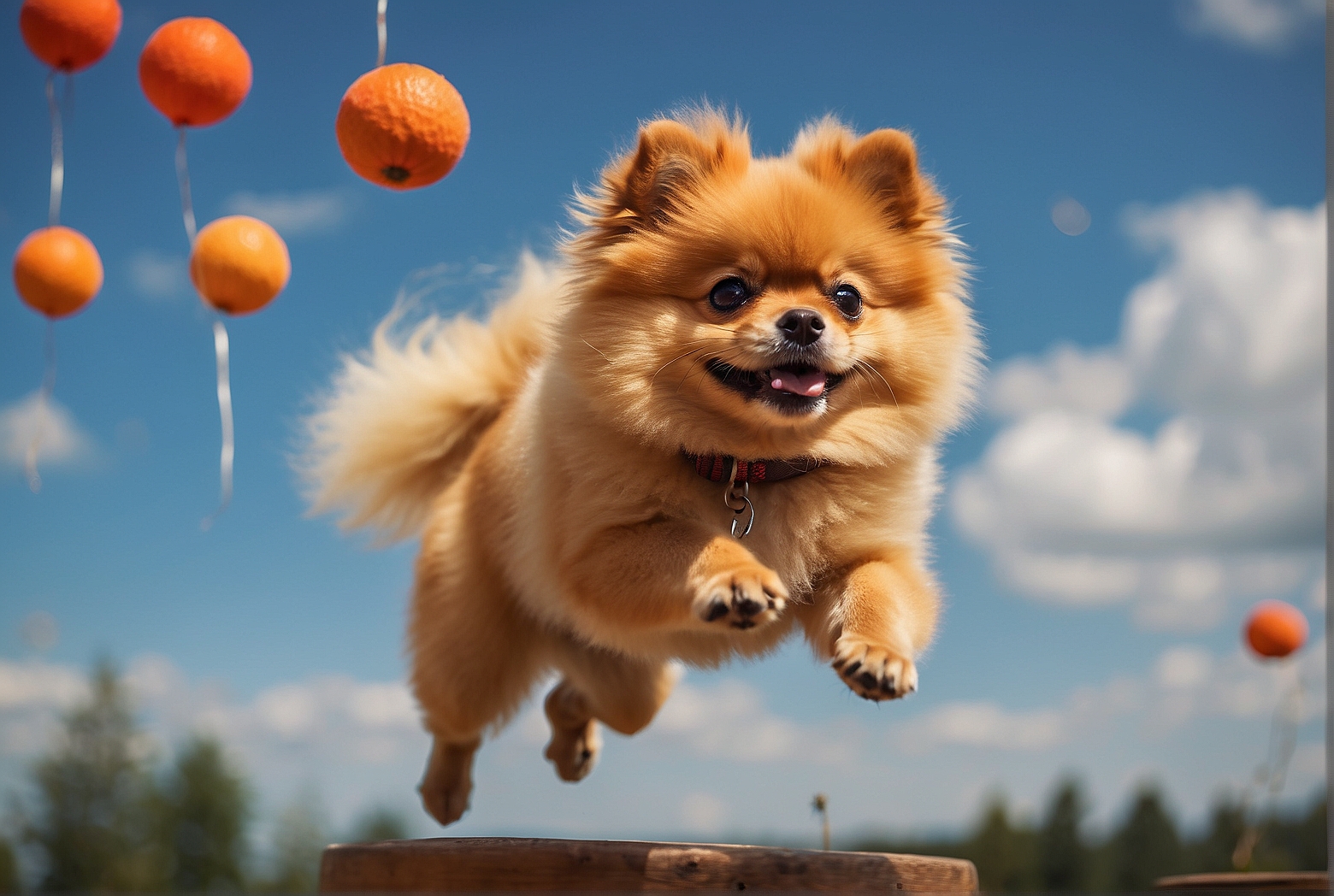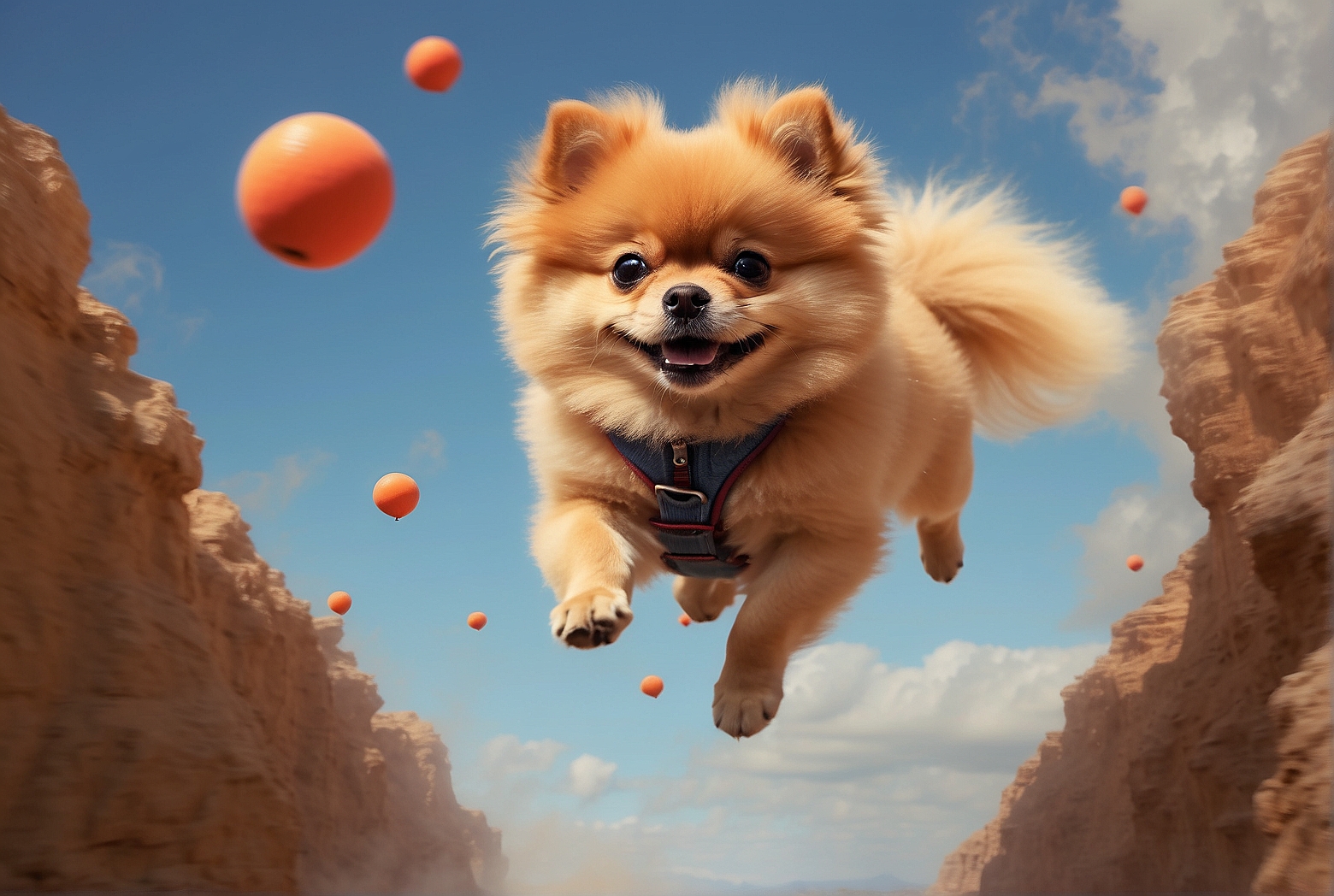Picture this: you’re at the park, enjoying a sunny afternoon, when suddenly you see a fluffy little Pomeranian effortlessly soaring through the air. You can’t help but wonder, can Pomeranians really jump that high? It’s a question that has fascinated dog lovers and curious minds alike. In this article, we’ll explore the incredible jumping abilities of these pint-sized pups and uncover just how high they can truly reach. So, buckle up and get ready to be amazed by the athletic prowess of Pomeranians!
Physical Characteristics of Pomeranians
Size and Weight
Pomeranians are small-sized dogs, typically weighing between three to seven pounds. Despite their diminutive size, they are surprisingly sturdy and well-built. They have a compact body with a deep and broad chest, giving them the appearance of a small lion. Their small size allows them to be easily carried or fit comfortably in your lap, making them excellent companions for people of all ages.
Muscular Strength
While Pomeranians may not have the same level of muscular strength as larger dog breeds, they still possess impressive muscle tone for their size. Their well-developed muscles enable them to perform various physical activities, including jumping, running, and playing. It’s essential to support their muscles through regular exercise and proper nutrition to maintain their overall health and strength.
Bone Structure
Pomeranians have a delicate bone structure that provides them with a light and agile physique. However, their bones are still strong enough to handle their daily activities. It’s crucial to ensure that their bones receive adequate support through a balanced diet rich in essential nutrients such as calcium and phosphorus. This helps promote healthy bone growth and prevents bone-related issues, such as osteoporosis or fractures.
Jumping Abilities of Pomeranians
Natural Jumping Ability
Despite their small stature, Pomeranians have surprising jumping abilities. They possess natural athleticism and agility, allowing them to gracefully leap over small obstacles or onto furniture. Their muscular hind legs provide the necessary power for these jumps, while their lightweight bodies enable them to achieve impressive heights relative to their size.
Training and Exercise
Training and exercise play essential roles in enhancing a Pomeranian’s jumping abilities. Regular exercise, such as walks or playtime, helps strengthen their muscles and improves overall physical fitness. Additionally, specific training exercises can be introduced to enhance their jumping skills. Through consistent practice and positive reinforcement, Pomeranians can develop their jumping techniques and reach even greater heights.

Jumping Height Comparison
When compared to larger dog breeds, Pomeranians may not reach the same heights during their jumps. However, considering their small size, they can still achieve remarkable jumping heights. On average, Pomeranians can jump up to a foot in the air, which is quite impressive when you consider their compact build. It’s vital to remember that each dog is unique, and individual factors like size, weight, and training can impact their jumping performance.
Factors Affecting Jumping Height
Size and Weight
Size and weight are crucial factors that influence a Pomeranian’s jumping height. As a smaller breed, Pomeranians generally have shorter legs compared to larger dogs, which can limit their vertical leap. Their lightweight bodies, though advantageous in some areas, can also impact their ability to generate enough upward force for higher jumps.
Muscular Strength
Muscular strength plays a significant role in determining a Pomeranian’s jumping abilities. A well-toned and strong musculature allows them to generate more power and propel themselves higher during jumps. Regular exercise and targeted muscle-building activities, such as obstacle courses or agility training, can help strengthen their muscles, enhancing their jumping prowess.
Bone Structure
The bone structure of a Pomeranian affects their jumping height as well. While their delicate bones provide agility and agility, they may not support the same level of force as larger, sturdier breeds. Proper nutrition is fundamental in ensuring their bones receive the necessary nutrients to maintain strength and minimize the risk of bone-related issues that could impact their jumping abilities.
Age and Health
Age and overall health also impact a Pomeranian’s jumping height. Younger, more energetic dogs may have better jumping abilities compared to older or less healthy dogs. Health issues such as arthritis or bone diseases can affect their mobility and limit their jumping capabilities. Regular check-ups with a veterinarian and a healthy lifestyle are crucial in maintaining optimal health and potentially improving their jumping skills.
Training and Discipline
Training and discipline are essential components in maximizing a Pomeranian’s jumping height. Consistent training, positive reinforcement, and patience can help them develop the appropriate techniques and strength necessary for higher jumps. Establishing a structured training routine and maintaining discipline can enhance their focus and performance during jumping exercises.

Preventing Excessive Jumping
Health Risks
Excessive jumping can pose health risks for Pomeranians. Due to their small size and delicate bone structure, repetitive jumping can lead to joint issues, such as patellar luxation or hip dysplasia. These conditions can be painful and may require medical intervention. It’s crucial to strike a balance between allowing them to exercise their jumping abilities and reducing the risk of potential injuries.
Injury Potential
Jumping excessively or from great heights increases the potential for injuries. Pomeranians may sustain injuries to their joints, bones, or soft tissues from abrupt landings or repetitive strain. It’s essential to provide a safe jumping environment and monitor their jumping activities to prevent accidents and minimize the risk of injuries.
Controlling Jumping Behavior
Controlling a Pomeranian’s jumping behavior is important to ensure their safety and well-being. Consistent training and reinforcement of boundaries can help establish proper jumping etiquette. Encouraging alternative behaviors, such as sitting or offering them designated jumping areas, can redirect their instinct to jump excessively.
Designated Exercise Areas
Designating specific areas for exercise can help manage a Pomeranian’s jumping tendencies. By providing designated spaces with cushioned surfaces or obstacle courses, you can encourage controlled jumping while minimizing the risk of injuries. These areas should be tailored to their size and jumping abilities, ensuring a safe and enjoyable exercise environment.
Training Tips for Jumping Pomeranians
Positive Reinforcement
Positive reinforcement is an effective training method for Pomeranians. Rewarding them with treats, praise, or toys when they perform desired jumping behaviors encourages them to continue displaying those actions. This training approach not only enhances their jumping skills but also strengthens the bond between you and your furry companion.
Obstacle Course Training
Introducing obstacle course training can be beneficial for Pomeranians with a passion for jumping. Gradually increasing the complexity of the obstacles encourages them to overcome challenges while improving their jumping technique. This type of training stimulates both their physical and mental abilities, keeping them engaged and motivated.
Regular Exercise Routines
Establishing regular exercise routines is crucial for Pomeranians, including those who enjoy jumping. Engaging in daily walks, play sessions, or interactive toys can help channel their energy and fulfill their exercise needs. Adequate physical activity not only supports their muscle development but also helps prevent behavioral issues due to pent-up energy.
Agility Training
Agility training is an ideal activity for Pomeranians who excel in jumping. This specialized training enhances their overall athleticism, agility, and coordination. An agility course involves various obstacles, such as tunnels, hurdles, and ramps, that encourage jumping and quick maneuvering. It provides mental stimulation and physical exercise while nurturing their jumping abilities.
Other Impressive Pomeranian Skills
Fetching and Retrieving
Pomeranians are excellent at fetching and retrieving objects. Despite their small size, they possess a strong retrieval instinct and enjoy engaging in this game. Their agility and quick reflexes enable them to swiftly maneuver and retrieve objects, making them a fun and active companion during playtime.
Trick Performances
Pomeranians are known for their ability to learn and perform impressive tricks. Their high intelligence and eagerness to please make them excellent candidates for trick training. Whether it’s spinning, rolling over, or playing dead, Pomeranians love to showcase their skills and entertain their owners, creating a strong bond through shared activities.
Smartness and Trainability
Pomeranians are highly intelligent dogs with a remarkable capacity for learning. They are quick to pick up commands and respond well to positive reinforcement training methods. Their trainability makes them versatile pets, excelling in various activities such as obedience, agility, and even therapy work. With patience and consistency, you can unlock their full potential and witness their exceptional abilities.
Common Pomeranian Health Issues
Patellar Luxation
Patellar luxation is a common orthopedic condition in Pomeranians. It occurs when the kneecap (patella) slips out of its normal position. This condition can cause limping, pain, and difficulty in walking or jumping. Regular veterinary check-ups and maintaining a healthy weight can help minimize the risk of patellar luxation.
Hip Dysplasia
Hip dysplasia is another common health issue among Pomeranians. It is a hereditary condition where the hip joint doesn’t develop properly, leading to joint instability and discomfort. Regular exercise, a balanced diet, and weight management are crucial in minimizing the risk and managing this condition.
Collapsed Trachea
Pomeranians are prone to collapsed trachea, a condition where the windpipe narrows or becomes weakened. It can cause breathing difficulties, coughing, and gagging. Using a harness instead of a traditional collar while walking your Pomeranian can help reduce the stress on their neck and minimize the risk of tracheal injuries.
Consulting a Veterinarian
Assessing Physical Condition
Regular consultations with a veterinarian are essential in assessing your Pomeranian’s physical condition. A thorough examination can help identify any underlying health issues, evaluate their jumping abilities, and provide personalized recommendations for training and exercise routines.
Health and Fitness Advice
Veterinarians can offer valuable advice on maintaining your Pomeranian’s overall health and fitness. They can provide guidance on appropriate nutrition, exercise routines, and preventive measures to minimize the risk of injuries or health issues associated with jumping. Consulting a veterinarian can help ensure your furry friend lives a healthy and fulfilling life.
Understanding Pomeranian Behavior
Curiosity and Alertness
Pomeranians are known for their curious and alert nature. They are always on the lookout for new experiences and can quickly react to changes in their environment. This inherent curiosity fuels their desire to explore and investigate, making each day an exciting adventure.
Lively and Active Nature
Pomeranians have a lively and energetic nature. They thrive on physical activity and mental stimulation. Their jumping abilities are often a manifestation of their liveliness and desire to engage in playful activities. Adequate exercise and interactive playtime are essential in providing them with a positive outlet for their energy.
Attachment and Playfulness
Pomeranians are highly attached to their owners and enjoy spending quality time with them. They are playful companions and love to participate in various activities, including jumping, fetching, or agility training. Engaging in these interactive games not only reinforces their jumping skills but deepens the bond between you and your furry friend.
Territorial and Protective Instincts
Pomeranians may exhibit territorial or protective instincts. Their barking and alertness are often expressions of their dedication to safeguarding their family and territory. Proper socialization and training can help manage these instincts while ensuring a balanced and sociable temperament.
Conclusion
Pomeranians possess impressive physical characteristics and jumping abilities, despite their small size. Their muscular strength, bone structure, and training can influence their jumping height. However, it’s essential to consider factors such as size, weight, and health when evaluating their jumping potential.
Preventing excessive jumping is crucial to avoid health risks and injuries. By providing designated exercise areas and controlling their jumping behavior, you can strike a balance between allowing them to exercise their natural abilities and keeping them safe.
Training plays a vital role in enhancing a Pomeranian’s jumping skills. Through positive reinforcement, obstacle course training, regular exercise routines, and agility training, you can help them develop their jumping technique and coordination.
In addition to their jumping abilities, Pomeranians possess other impressive skills. With their intelligence, trainability, and eager nature, they excel in various activities, such as fetching, trick performances, and obedience training.
Understanding common health issues that Pomeranians may face, consulting a veterinarian, and maintaining their overall well-being are essential for their longevity and quality of life.
Lastly, understanding their behavior, such as their curiosity, liveliness, attachment, and protective instincts, offers valuable insights into their unique personality traits and strengthens the bond between you and your Pomeranian companion.
